July 24 2013
Past-present tensions
Keith Gallasch, Naala-Ba (Look Future), Carriageworks and ISEA2013
July 3 2013
Data noise & the limits of dance
Keith Gallasch, Myriam Gourfink & Kaspar Toeplitz, Breathing Monster
June 26 2013
Nailing the virtual
Virginia Baxter, Keith Gallasch, The Portals
Night work
Keith Gallasch, Embodied Media, Night Rage
Palpable virtualities
Keith Gallasch, Paula Dawson, Holoshop: Drawing and Perceiving in Depth
The big connect
Somaya Langley, The Portals
Transformational walking
Anne Phillips, Long Time, No See?
June 18 2013
Musical multiverses
Gail Priest, Polysonics
Rainbow over ISEA
Keith Gallasch, Electric Nights
realtime tv @ ISEA2013: Zydnei, Troy Innocent
June 17 2013
If a system fails in a forest, is anybody listening?
Urszula Dawkins, If a system fails in a forest…, 107 Projects
June 16 2013
In the digital age, love your stationery obsession
Urszula Dawkins, Durational Book
Painting by algorithms
Keith Gallasch, Ernest Edmonds: Light Logic
June 15 2013
Home, sweet home
Urszula Dawkins, disSentience, Sleeth, SelgasCano, Tin Sheds
Pop up pleasure zones
Gail Priest, Electronic Art Pop-Ups, The Rocks
June 14 2013
Aural ecologies, mechanical and musical
Urszula Dawkins, EchoSonics, UTS Gallery
June 14 2013
Heck, baby, I shoulda seen it comin…
Urszula Dawkins, The Very Near Future, Alex Davies
More than meets the eye
Virginia Baxter, Keith Gallasch, Point of View
New tools and old skool grammars
Gail Priest, Macrophonics II
realtime tv @ ISEA2013: The very near future, Alex Davies
Start by leaping off a small stool
Urszula Dawkins, ISEA Closing Keynote Address: Julian Assange
June 13 2013
A curative dose of spontaneity
Lauren Carroll Harris, pvi collective, Deviator
M e d i a a r t t h e n a n d n o w
Darren Tofts, Catching Light, Campbelltown Arts Centre
Olfaction, decay & speculation
Gail Priest, Raewyn Turner & Brian Harris, Ian Haig, Nandita Kumar, Verge Gallery
ART, WELLNESS & DEATH
Riding the theta waves
Urszula Dawkins, Theta Lab, George Poonkhin Khut and James Brown
Run for your lives [2]
Keith Gallasch, Running the City, COFA, UNSW
To re-map and reclaim
Lisa Gye, Mapping Culture [panel]
Turning the media back on itself
Lisa Gye, Mark Hosler, Adventures in Illegal Art
June 12 2013
Outside the labyrinth…looking in at someone waving
Urszula Dawkins, SoundLabyrinth, Mark Pedersen and Roger Alsop
realtime tv @ ISEA2013: semipermeable (+), SymbioticA
Run for your lives [1]
Keith Gallasch, Marnix de Nijs, Run Motherfucker Run
June 12 2013
The uncanny in the gallery
Keith Gallasch, Mari Velonaki, Simon Ingram, Petra Gemeinboeck & Rob Saunders, Artspace
June 11 2013
realtime tv @ ISEA2013: EchoSonics, UTS Gallery
The science and art of tangible things
Urszula Dawkins, Synapse: A Selection, Powerhouse
Touch me there
Gail Priest, ISEA Artist talks: Siu, Baumann, Velonaki
June 10 2013
Being Stelarc
Gail Priest, Stelarc: Meat, Metal, Code: Engineering affect and aliveness
Life and death, and the membranes inbetween
Urszula Dawkins, semipermeable (+), SymbioticA
realtime tv @ ISEA2013: Catching Light, Campbelltown Arts Centre
June 9 2013
'Pure' experience, in the round
Urszula Dawkins, Pure Land, iCinema
Data lives
Gail Priest, Genevieve Bell, Mark Hosler, Paolo Cirio & Alessandro Ludovico
realtime tv @ ISEA2013: Velonaki, Ingram, Gemeinboeck & Saunders, Artspace
June 8 2013
Knowing your place in Cartesian space
Gail Priest, Ryoji Ikeda, datamatics [ver 2.0]
Stars and starlings, pixels and picknickers
Urszula Dawkins, Ryoji Ikeda, datamatics [ver 2.0] & test pattern
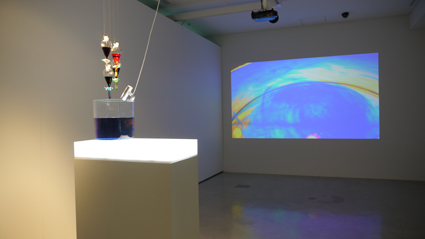 |
Jon Drummond, Flowforms
photo Gail Priest |
Echo- or eco? The title EchoSonics is, depending on your accent, homonymic – and it’s the ‘eco-’ aspects of these works that unifies them: in the words of curator Nigel Helyer, the exhibition is an investigation of “acoustic ecologies”. From Ed Osborn’s study of ice-bound Svalbard to Mark Brown’s determinedly obscure Detritical Re-Vibration/Techtonic Transfer; via Minoru Sato’s ‘high-voltage hot and cold’ and two self-performing works by Jon Drummond, EchoSonics elegantly charts forays into representation, abstraction, reification and translation respectively.
Ecology is ostensibly the study of environments, but its real focus is the interrelationships that exist within them. And in EchoSonics, it’s never just sound, but always the relationship of sound to objects, physical phenomena, and our other senses, that provides traction for the conceptual underpinnings of the works.
Ed Osborn – Albedo Prospect
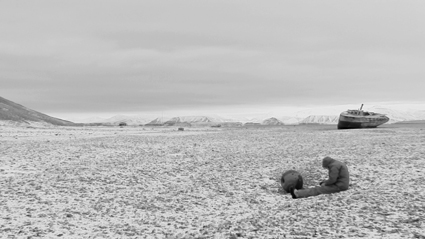 |
Ed Osborn, Albedo Prospect (video still)
courtesy the artist |
Sound and video form the foundational relationship in Albedo Prospect. A tryptich of large video screens shows slowly moving ice, still landscapes and long, smooth pans that reveal only scree and snow. The sounds are diegetic – trickling water, the faint rustle of clothing or wind. Huge-scale glaciers are resolved in perfect tonal detail, their bulk contrasting with the tiny remnants of ice and the subtle, sloshing, melting sounds of their decay. It’s meditative, distant – yet feels very ‘live’, setting up a relationship of familiar and strange.
As Osborn notes, the Arctic remains a place of essential ‘otherness’, although it has now been documented and explored extensively. He references the now-lost radio transmissions of Arthur Koestler from a 1931 airship flight over the Arctic; and has elsewhere described Albedo Prospect as a re-imagining of these missing reports. The work is the most directly ‘representational’ of EchoSonics, but its focus is poetic rather than literal, addressing loss, being-lost-ness, and perhaps the loss of our ability to be lost. It suggests our continuing otherness in relationship to what, in theory, is thoroughly mapped and knowable.
Jon Drummond – Twittering Machine and Flowforms
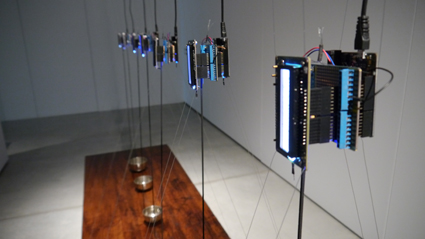 |
Jon Drummond, Twittering Machine
photo Gail Priest |
Two works by Jon Drummond explore markedly different phenomena to produce aurally captivating and sensually rich sound-worlds. Flowforms synaesthetically links colour and sound, as the diffusion of bright dyes within a body of viscous liquid generates a sonic translation through headphones; a close-up shot of the slow-swirling, inanimate process adds a psychedelic component. Twittering Machine takes the global cacophony of Twitter – an abstracted, constant flow of random ‘tweets’ – and translates them electronically to an apparatus of singing-bowls struck gently by quivering wands. The subtle, melodic result feels deeply intentional and random at once, suggesting the endless chatter of cyberspace subsumed by quiet imaginings.
Mark Brown – Detritical Re-Vibration/Techtonic Transfer
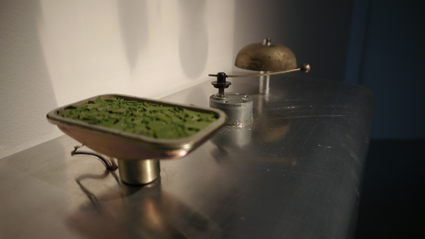 |
Mark Brown, Detritical Re-Vibration/Techtonic Transfer
photo Gail Priest |
Described by Helyer as the ‘wild card’ of EchoSonics (see
video interview), Detritical Re-Vibration/Techtonic Transfer is a work of abstracted origins that triggers a feeling of cool mystery. Constructed of industrial artefact, solenoid and servomotor, a sporadically spinning clapper glances against a small bell, just enough to polish a streak across its surface; accompanied by an insect-like, mechatronic whirr. On a screen above, glimpses of fragments of…something…fleetingly appear, visually echoing a small tray of copper-green detritus mounted alongside the spinning arm. In his interview for ISEA-in-RealTime, Nigel Helyer explains these subliminal video frames – they are 1/250th of a second snapshots of a speaker vibrating along with paint peelings and other fragments. The ‘ecology’ exposed here is that of our usually-privileged visual world, upturned to deliver a sound-world that, while somewhat arcane, is nevertheless continuous.
Minoru Sato – Thermal Acoustics
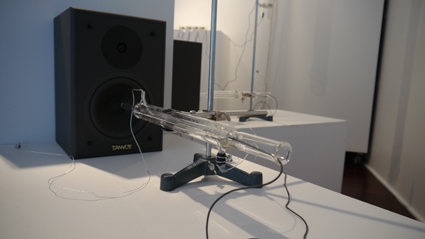 |
Minoru Sato, Thermal Acoustics
photo Gail Priest |
In Thermal Acoustics, Minoru Sato beautifully aestheticises and concretises the phenomenon of heat in visible and aural form. A complex apparatus of multi-chambered glassware, wiring, mics and speakers, including four large, identical hanging tubes, initially eludes comprehension, humming softly across high and low frequencies while a mysterious brass ball is dragged mechanically around a metal plate to generate dry sparking sounds. Luckily, the artist appears just at the right moment and explains to me what’s happening: miniature heating elements inside some of the tubes change their resonating frequencies slightly, so that feedback loops created in each of the four large tubes and four small ones generate beat frequencies or standing waves. What are essentially the result of sonic differences combine to create an aural environment of soft harmony. As Sato, trained as a physicist, explains, such phenomena exist everywhere, all the time; in Thermal Acoustics, heat becomes a listening experience.
EchoSonics, UTS Gallery, 4 June 12 July; http://www.isea2013.org/
This article first appeared on the ISEA2013 in RealTime blog
© Urszula Dawkins; for permission to reproduce apply to [email protected]
Back to top













 back
back